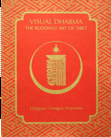Five
Buddha Family
Some impression concerning the nature of the five buddha-family
principles is essential to an understanding of tantric Buddhist
art. Direct relationships with those five energies is the basis
of tantric Buddhist practice.
The
five buddha principles constitute the basic mandala with vajra in
the east, ratna in the south, padma in the west, karma in the north
and buddha or Tathagata in the center.
Vajra
 Vajra
is associated with anger, which is transmuted into mirrorlike wisdom.
In the cloudiness, possessiveness and aggression of anger, there
are qualities of brilliance, lucidity, great energy. Vajra
is associated with anger, which is transmuted into mirrorlike wisdom.
In the cloudiness, possessiveness and aggression of anger, there
are qualities of brilliance, lucidity, great energy.
Seeing these
qualities clearly in the vajra yidam, the essence of anger is spontaneously
transmuted into openness and precision. Transmutation is not performed
deliberately but automatically follows upon clear insight.
Vajra is associated
with the element of water. Cloudy, turbulent water symbolizes the
defensive and aggressive nature of anger. Clear water suggests the
sharp, precise, clear reflectiveness of mirrorlike wisdom. The color
white, also associated with vajra, expresses both the all-pervading
ice storm of anger and the brilliant reflectiveness of mirrorlike
wisdom. Vajra’s direction is the east, which is connected
with the dispassionate clarity of dawn. The symbol of the vajra
family is the vajra (T.: Dorje; Tt.: rdo rje), the thunderbolt scepter
which betokens indestructibility and precision.
Ratna

The energy of ratna, when expressed neurotically, is pride or arrogance,
which can be transmuted into the wisdom of equanimity. Ratna is
connected with the element earth and is alive to the quality of
solidity or substantiality. Taking this from the neurotic angel
of samsara or ego, there is the constant anxiety of not being substantial
enough; so one tries to build a tower of pride that will obviate
all challenge. In the enlightened energy of the ratna yidam, one
comes in contact with the quality of inexhaustible richness. Seeing
this, pride is spontaneously transmuted into the wisdom of equanimity.
The wisdom of equanimity, imbued with generosity, sees all situations
equally as ornaments of basic being.
Ratna is associated
with the warmth, full sunshine and lushness of the south. Its color
yellow can express either the putrescence of pride of the richness
and well-being of gold. The ratna family symbol is the jewel, which
fulfills all wishes.

Padma
The energy of the padma family is associated with the element of
fire. Distorted by ego, it expresses itself as passion. Passion
can be transmuted into discriminating wisdom. A neurotic sense of
insufficiency creates the ambition to possess particular aspects
of the phenomenal world, to consume like flame their quality of
otherness. Through experiencing a sense of total compassion in the
padma yidam, passion is transmuted into an energy of enlightened
relationship, which sees with warmth and clarity precisely what
exists to be related to.
Padma is connected
with the west and with the brilliant display of the colorful qualities
of existence expressed in the sunset. Its color red evinces the
seduction and heat of passion or the all-pervading warmth of compassion.
The symbol of the padma family is the lotus of compassion, the purified
form of passion.
Karma

Karma family energy manifests neurotically as jealousy and on the
awakened level as all-accomplishing wisdom. It is the energy of
the element of wind which is present everywhere, touching all corners
of space. Therefore, in the neurotic manifestation, it is aware
of all facets of situations as something it has to keep up with
or that it is left out of. If, through relating with the karma yidam,
ego’s reference point is overwhelmed, the same energy becomes
active in every area of situations, doing whatever needs to be done
and destroying all obstacles to the fulfillment of enlightenment.
Karma is connected
with the cold, stormy energetic quality of the north. Its color
is green, expressing either envy or the energy of all-pervading
action. The karma family symbol is either a sword or a double vajra,
both of which denote the fulfillment of all actions.

Buddha or Tathagata
The buddha energy is that which creates stupidity through the ability
to play deaf, dumb and blind to anything that threatens the low-level
stability created by ego. This same uncanny ability to be aware
of everything in order to turn away from it can be stripped of the
turning- away or ignoring function. Through the insight that comes
from relating to the totally awakened form of the buddha yidam,
ego’s game is exposed and stupidity transmutes into the wisdom
of fundamental all-pervading awareness.
The
buddha family’s color is the blue of its element space, which
can either be just dull and blank or alive with the ubiquity of
intelligence. A wheel is the symbol of the buddha family, indicating
all-pervading rule.
back
to top
...........................................................................................................................................................................................................
Essay © 1975 Chogyam Trungpa Rinpoche
copyright © 2003 Shelly and Donald Rubin Foundation
|

